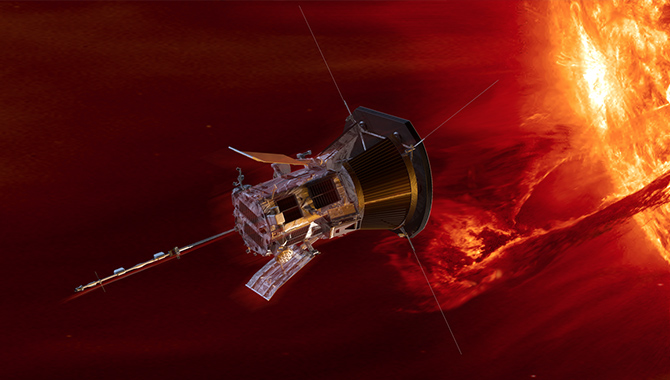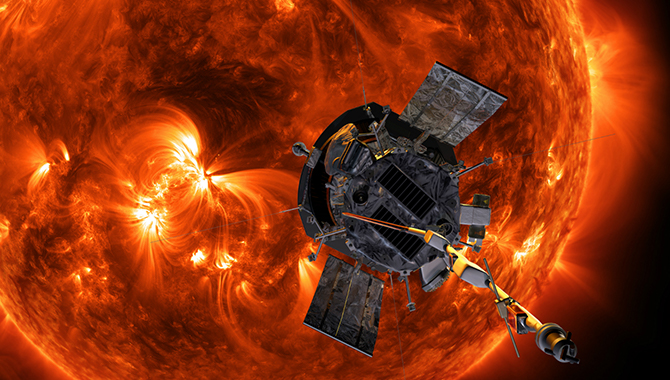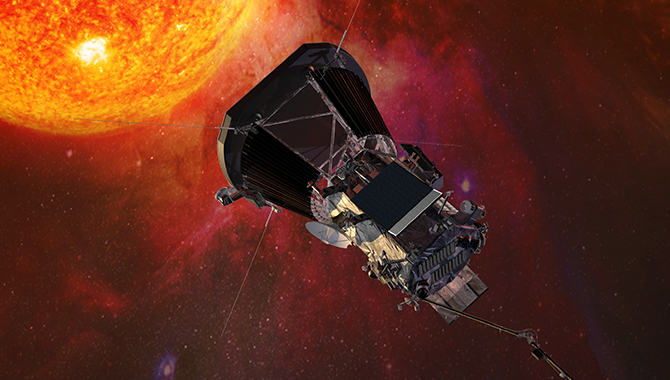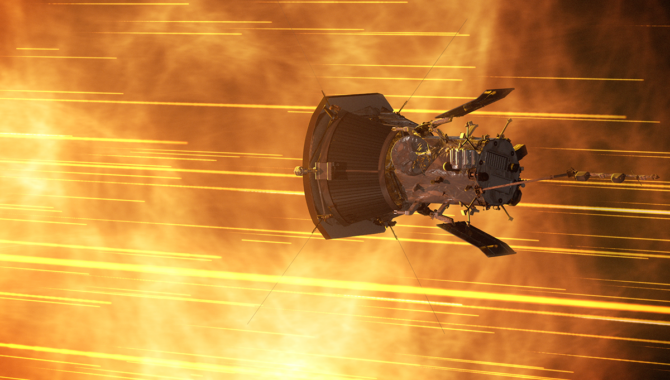
An artist's concept of NASA's Parker Solar Probe. Credit: NASA
Team wins prestigious award for mission that has rewritten scientific understanding of solar processes.
The Sun, measuring about 865,000 miles in diameter, is considered an average star. It pales in comparison to the largest examples in the Milky Way galaxy—some of which are more than 1,500 times larger and as much as 400,000 times brighter. The largest known, UY Scuti, has a staggering volume about 750 million times that of the Sun.
But in the context of the solar system, where it accounts for 99.86 percent of the total mass, the Sun is profound. All eight planets, 891 known moons, millions of asteroids, comets, and all of the objects in the distant Kuiper Belt would fit comfortably into a tiny fraction of the Sun’s volume. In fact, it would take 1.3 million Earths to fill that volume.

This image from June 20, 2013, at 11:15 p.m. EDT shows the bright light of a solar flare on the left side of the sun and an eruption of solar material shooting through the sun’s atmosphere, called a prominence eruption. Credit: NASA/Goddard/Solar Dynamics Observatory
For much of human history, the Sun has been a mystery. It was never undiscovered. It lit the sky, marked the passage of days, and sustained life. But it wasn’t until 1925 that astrophysicist Cecilia Payne-Gaposchkin revealed the Sun was made mostly of hydrogen and helium, defying assumptions that it shared Earth’s composition. And it was 1939 when Hans Bethe began his Nobel Prize winning work describing the process of nuclear fusion that powers the Sun.
At the dawn of the space age, key questions remained. And as NASA missions answered some questions, the findings raised new ones.
To better understand the Sun, NASA launched the Parker Solar Probe in 2018 aboard a Delta IV Heavy rocket, assisted by a third-stage booster to escape Earth’s gravity. Since then, it has performed seven gravity-assist flybys of Venus, tightening its orbit until it is now passing seven times closer to the Sun than any spacecraft in history.
On June 19, 2025, the Parker Solar Probe will once again draw to within 3.8 million miles of the visible surface of the Sun, following similar orbits on Dec. 24, 2024, and March 22, 2025. Traveling 430,000 miles per hour, it will mark the probe’s 24th close encounter with the massive star at the center of our solar system, passing through the corona, where temperatures can reach 3.5 million degrees Fahrenheit.
The Parker Solar Probe was developed to pursue answers to questions that have puzzled scientists for decades. Why, for instance, is the Sun’s outer atmosphere millions of degrees hotter than the surface below? And what accelerates the stream of particles leaving the Sun to supersonic speeds?
The mission has already rewritten heliophysics textbooks. The probe has returned data that revealed the edge of the corona is far more jagged than previously thought. It also pinpointed the source of zig-zag magnetic structures in the solar wind. The probe has also tracked the behavior of high-energy solar particles, discovered how coronal mass ejections sweep up dust as they travel through space, and even captured the first full image of an orbital dust ring at Venus.
The Parker Solar Probe has given scientists a new perspective in studying the Sun. It has answered key questions about the solar wind and its acceleration. These close approaches will provide more data to understand how the solar wind accelerates closer to the surface.

As Parker Solar Probe passed through the corona on encounter nine, the spacecraft flew by structures called coronal streamers. These structures can be seen as bright features moving upward in the upper images and angled downward in the lower row. Such a view is only possible because the spacecraft flew above and below the streamers inside the corona. Until now, streamers have only been seen from afar. They are visible from Earth during total solar eclipses. Credit: NASA/Johns Hopkins APL/Naval Research Laboratory
The spacecraft is an engineering marvel. Its high-performance heat shield is 8 feet in diameter and is less than 5 inches thick. It comprises a lightweight 4.5-inch-thick carbon composite foam core sandwiched by two carbon composite panels. It weighs just 160 pounds but can withstand temperatures of 2,500°F.
Behind the heat shield, the spacecraft and scientific instruments remain a comfortable 85°F. The probe carries a suite of sophisticated instruments that measure particles, magnetic fields, and solar wind structures. A single wide-field imager captures large-scale events in the corona.
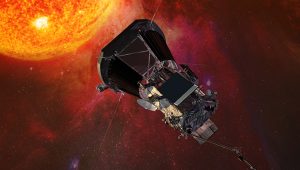
Illustration of the Parker Solar Probe spacecraft approaching the sun. Credit: Johns Hopkins University Applied Physics Laboratory
The probe is powered by solar arrays that are cooled by a closed-loop liquid system to maintain a safe temperature while generating power in the intense glare of the Sun. Because the Sun often blocks direct communication, the probe is equipped with a highly autonomous system of sensors and controls that quickly reposition the spacecraft as it flies through the chaos of the corona.
Days after the close approach in March 2025, the Parker Solar Probe team learned they have been selected to receive the prestigious 2024 Robert J. Collier Trophy. One of the most prestigious awards in aerospace, the Collier is presented by the National Aeronautic Association (NAA), in recognition of the year’s most exceptional achievement in American aeronautics or astronautics. The trophy resides in the Smithsonian’s National Air and Space Museum in Washington, D.C.
“The Collier Trophy is a recognition like no other, and the Parker Solar Probe Team’s achievement in earning the 2024 Collier is an extraordinary example of determination, genius, and teamwork. It is our distinct honor to acknowledge and celebrate the remarkable team that turned the impossible into reality,” said Amy Spowart, NAA President and CEO, in a press release.
The mission is part of NASA’s Living with a Star flight program, managed by Goddard Space Flight Center in Greenbelt, Maryland, for NASA’s Science Mission Directorate in Washington, D.C. The Johns Hopkins University Applied Physics Laboratory implements the mission for NASA. Scientific instrumentation is provided by teams led by the Naval Research Laboratory, Princeton University, the University of California, Berkeley, and the University of Michigan.






